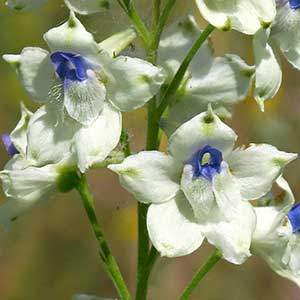Delphinium nuttallii subsp. ochroleucum
(synonym of Delphinium leucophaeum)
Delphinium californicum
pale larkspur, white rock larkspur
California larkspur, coast larkspur
30-60 cm.
(60-)100-160(-230) cm;
base reddish, puberulent-glabrous.
blade pentagonal to round, 3-9 × 3-12 cm, puberulent; ultimate lobes 3-15, width 5-60 mm;
midcauline leaf lobes less than 3 times longer than wide.
(16-)40-90(-162)-flowered;
pedicel 0.5-2.5(-6.5) cm, puberulent;
bracteoles 2-5 mm from flowers, reddish, linear, (3-)7-12(-15) mm, puberulent.
sepals white or light yellow, spurs 9-11 mm;
lower petal blades 4-6 mm.
sepals lavender to greenish white, abaxially puberulent, lateral sepals forward pointing to form a pseudotube, 6-11 × 5-7 mm, spurs straight, slightly ascending, apically downcurved, 7-11(-14) mm;
lower petal blades elevated, ± exposing stamens, 3-5 mm, clefts 1.5-2.5 mm;
hairs covering adaxial surface, white or light yellow.
11-16 mm, 2.5-3.5 times longer than wide, glabrous to sparsely puberulent.
unwinged;
seed coat cells elongate, surfaces ± roughened.
= 16.
Delphinium nuttallii subsp. ochroleucum
Delphinium californicum
Of conservation concern.
The range of morphologic features of Delphinium nuttallii subsp. ochroleucum (D. leucophaeum) is almost completely encompassed within that of D. nuttallii subsp. nuttallii. Sepal color is the only feature consistently separating the two subspecies. Were it not for the fact that any given population typically has plants of only one flower color, a rank of forma would be more appropriate.
(Discussion copyrighted by Flora of North America; reprinted with permission.)
Subspecies 2 (2 in the flora).
Delphinium californicum can be confused only with D. glaucum or D. exaltatum. The three species may be separated by the abundant pubescence and early flowering date of D. californicum as compared to the other two taxa, low elevation sites of D. californicum compared to D. glaucum, and western geographic distribution of D. californicum compared to D. exaltatum.
(Discussion copyrighted by Flora of North America; reprinted with permission.)
1. Sepals lavender; inflorescences puberulent; upper petals hairy. | subsp. californicum |
1. Sepals greenish white; inflorescences nearly glabrous; upper petals glabrous. | subsp. interius |


